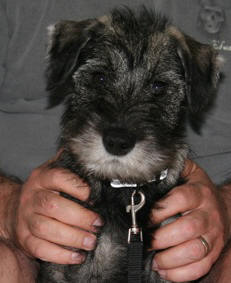  |
|||
|
|
|||
| Traditionally the Schnauzer ear has been surgically cropped and trained to stand in an alert manner. This practice of cropping ears has however fallen into disfavour with the majority of countries around the world. I am not going to argue the rights vs. wrongs of the practice of cropping. I have always, and will always love the look of a nicely cropped and trained ear, however at Dinsdale we have decided we will no longer be offering the cropped ear style on our pups. If you prefer the cropped ear style we respect that and encourage you to approach other breeders about their cropping policy. We will not change our minds, our pups are sold with the natural ear and are NOT to be cropped on leaving our premises. If you want the cropped ear that's great, please find a breeder that will have the ears cropped properly and healed before you take your pup home. Ear cropping should be done by a Veterinarian that is experienced in ear cropping and is familiar with the different ear crop style as it applies to the different breeds. All breeds do not have the same ear crop style, all vets are not naturally skilled and talented in creating a beautiful ear crop. Post surgery care is very important and should be taken care of by an experienced breeder, do not take this on without the support of the pups breeder. |
 |
||
|
The Canadian
Kennel Club Breed Standard for the Standard Schnauzers describes the
Natural (un-cropped) ear as: |
|||
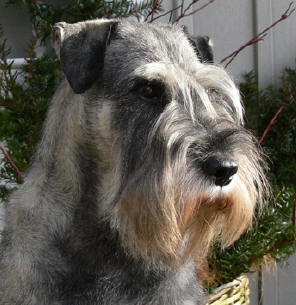 |
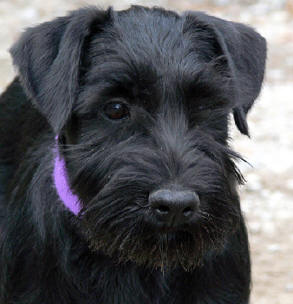 |
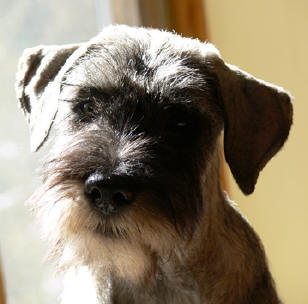 |
|
|
|
|||
|
As soon as you notice the pups ears straying from the
correct set for more then a day or two it is time to get out the tape.
Generally when the pups leave us the ears are set perfectly, take a photo
of your pup at this time and use it for reference. I find I have to
tape the pups ears around 10 weeks of age, I leave it on for 3 days remove
and ears are usually fine for about 4-6 weeks. Pups start to loose
their puppy teeth starting around the 4th month, at this time ears will
often start to change, either flying out, up or folding back. When I
see this I start to tape again. It maybe necessary to tape 3-4 times
over the next 4-6 months while the pups adult teeth erupt. If you
are vigilant at this time, ears should look wonderful once the adult teeth
are in. If you choose not to tape during teething and wait until the pup is 6 months or older the chances of the ears ever sitting properly are very slim. Some pups are blessed with ears that rarely, or, never need taping, but most will benefit from one or two tapings. Really not a lot of work considering you will be looking at those ears for the next 12 to 15 years. |
|||
Puppy in need of corrective taping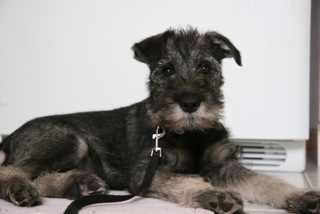 |
Photos taken before and after of the
same puppy. To the left you can see the pups left ear is flying out
to the side of his head. His right ear is starting to rise up high
on the head like a Terrier ear. Both of these ears are incorrect for
a Standard Schnauzer. |
|
|
|
|
|||
|
Step by Step process of taping the natural ear Only tools required is tape, patience and being more stubborn then your Schnauzer :-)) I prefer 1/2 inch masking, or, painters tape. The tape is inexpensive, readily available and can be removed without pulling out hair. Only problem is masking tape does not allow the ear to breath, DO NOT leave ears taped for more then 3 days in a row. In preparation I tear off several pieces of tape in various lengths. Taping is best done with two people until you get the hang of it. The first area I tape is the ears, pulling them forward (see photo A) and taping each ear separately with a 3-4 inch piece of tape. Next I tape a piece twice that length and run it from one ear, across the top of the skull (see photo B) to the other ear. I do the same under the chin, running from one ear, under the chin (see photo C) meeting up with the other ear. Once I have that on I tape a very long piece of tape and wrap one continual piece (long enough to go right around the pups head) starting at one ear, across the top of the skull to the other ear, down the cheek and under the chin and back up to the first ear. Take your time, stay calm and use as many pieces of tape as required to secure. It isn't important that the tape looks good, only that you have the ears taped in the correct position. Remove tape after 2-3 days, evaluate the ears for a couple of days and if they look good, leave. If the ears are still not sitting correctly, re-tape for another 2-3 days. |
|||
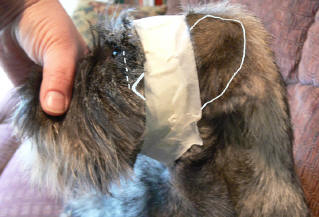 Click photo to enlarge |
Photo A
Pull the ear forward, depending on the size of your
pups ear it may only reach the back corner of it's eye. If you are dealing
with a larger ear pull past the eye and tape it into position slightly
below the eye. |
||
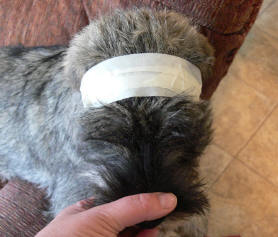 Click photo to enlarge |
Photo B
|
||
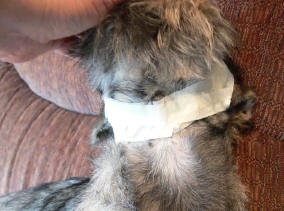 Click photo to enlarge
|
Photo C
And finally, this photo is of the pups head tilted
right back, tape runs around the chin. |
||
| Return Home | |||
